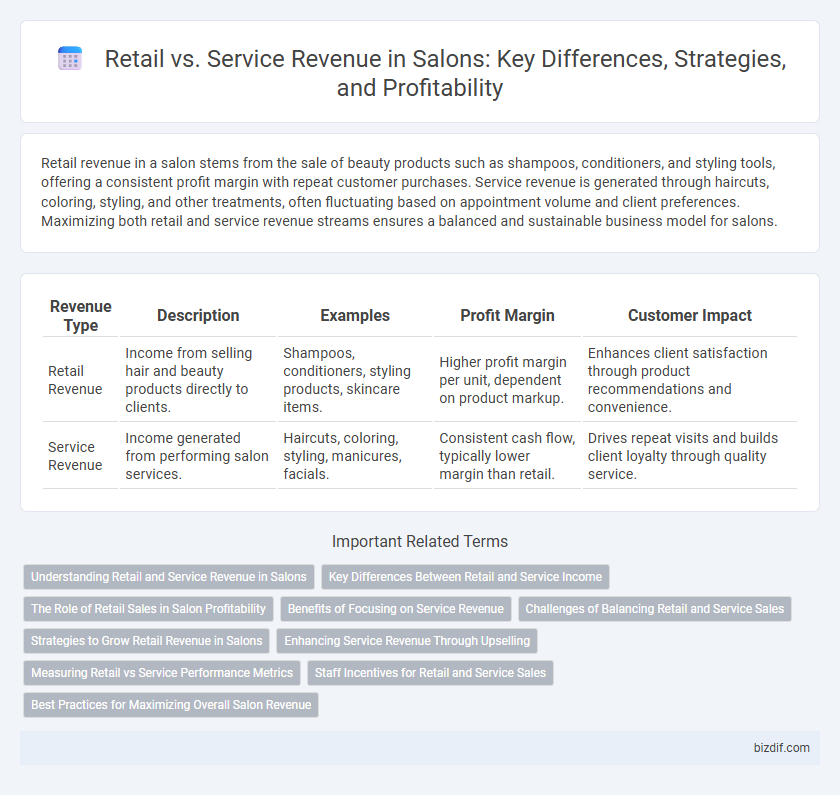Retail revenue in a salon stems from the sale of beauty products such as shampoos, conditioners, and styling tools, offering a consistent profit margin with repeat customer purchases. Service revenue is generated through haircuts, coloring, styling, and other treatments, often fluctuating based on appointment volume and client preferences. Maximizing both retail and service revenue streams ensures a balanced and sustainable business model for salons.
Table of Comparison
| Revenue Type | Description | Examples | Profit Margin | Customer Impact |
|---|---|---|---|---|
| Retail Revenue | Income from selling hair and beauty products directly to clients. | Shampoos, conditioners, styling products, skincare items. | Higher profit margin per unit, dependent on product markup. | Enhances client satisfaction through product recommendations and convenience. |
| Service Revenue | Income generated from performing salon services. | Haircuts, coloring, styling, manicures, facials. | Consistent cash flow, typically lower margin than retail. | Drives repeat visits and builds client loyalty through quality service. |
Understanding Retail and Service Revenue in Salons
Service revenue in salons primarily stems from haircuts, styling, coloring, and treatments, reflecting the core expertise and personalized client interactions. Retail revenue is generated through product sales such as shampoos, conditioners, styling tools, and skincare items that complement salon services. Balancing both revenue streams enhances overall profitability by combining immediate service income with ongoing product sales and client loyalty.
Key Differences Between Retail and Service Income
Retail revenue in salons derives from product sales such as shampoos, conditioners, and styling tools, whereas service revenue stems from hairstyling, coloring, and treatment appointments. Retail income often provides higher profit margins due to product markups and repeat customer purchases, while service income relies heavily on skilled labor and appointment frequency. Understanding the balance between retail and service revenue is essential for optimizing overall salon profitability and customer satisfaction.
The Role of Retail Sales in Salon Profitability
Retail sales significantly enhance salon profitability by providing consistent revenue beyond appointment services. Product sales, such as shampoos, conditioners, and styling tools, create higher profit margins and encourage client loyalty through at-home care. Integrating retail with service offerings increases overall transaction value, boosting total salon revenue and sustaining business growth.
Benefits of Focusing on Service Revenue
Focusing on service revenue in salons drives higher profit margins due to lower product costs and increased customer loyalty through personalized treatments. Service revenue also encourages repeat visits, boosting long-term client retention and overall business stability. Prioritizing services enhances brand reputation by showcasing expertise and quality, which can lead to more referrals and sustained growth.
Challenges of Balancing Retail and Service Sales
Balancing retail and service revenue in salons presents challenges such as inventory management complexities, where overstocking products can tie up capital while understocking limits sales opportunities. Staff training is critical for upselling retail products without detracting from service quality, requiring clear incentive structures and consistent performance monitoring. Furthermore, aligning promotional strategies to drive both retail and service sales demands precise data analytics to optimize customer experience and revenue mix effectively.
Strategies to Grow Retail Revenue in Salons
Boosting retail revenue in salons involves targeted product recommendations, in-depth staff training, and curated inventory that aligns with clients' hair or skincare needs. Implementing loyalty programs and offering exclusive retail discounts during services can significantly enhance product sales. Leveraging digital marketing and social media campaigns highlights retail offerings, driving more customer awareness and in-salon purchases.
Enhancing Service Revenue Through Upselling
Enhancing service revenue in salons relies heavily on strategic upselling techniques, such as recommending premium treatments or add-on services tailored to client needs. By training staff to identify opportunities during consultations, salons can increase average transaction value and improve customer satisfaction. Effective upselling not only boosts service revenue but also strengthens client loyalty and encourages repeat visits.
Measuring Retail vs Service Performance Metrics
Measuring retail versus service performance metrics in a salon involves analyzing revenue generated from product sales compared to income from salon services like haircuts or treatments. Key indicators include average retail transaction value, retail conversion rate, and service ticket average, which help identify strengths and growth opportunities. Tracking these metrics enables salons to optimize inventory, marketing strategies, and staff training for balanced profitability.
Staff Incentives for Retail and Service Sales
Staff incentives significantly boost both retail and service revenue in salons by motivating employees to upsell products and recommend premium services. Offering commissions or bonuses tied to retail sales encourages stylists to promote hair care, skincare, and beauty products, increasing overall retail profit margins. Incentivizing service sales leads to higher booking rates for treatments like haircuts, coloring, and spa services, enhancing client retention and maximizing salon profitability.
Best Practices for Maximizing Overall Salon Revenue
Maximizing overall salon revenue requires a strategic balance between retail and service revenue streams, with best practices including personalized product recommendations based on client hair types and treatment history. Implementing staff training programs enhances upselling skills and ensures consistent promotion of professional products that complement salon services. Leveraging data analytics to track customer preferences and purchase patterns enables targeted marketing campaigns that boost retail sales while maintaining high service booking rates.
Retail vs Service Revenue Infographic

 bizdif.com
bizdif.com